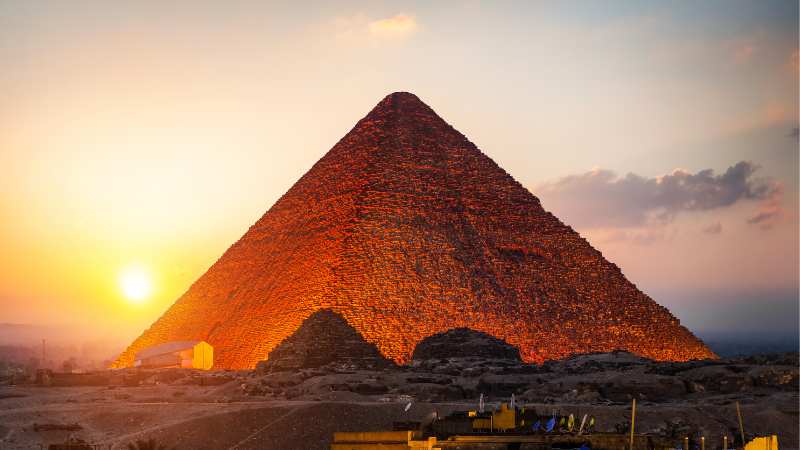(SQAUK) — The Great Pyramid of Giza, a marvel that has captivated historians, archaeologists, and conspiracy theorists for centuries, holds a secret that intrigues and baffles us. Among the myriad of theories about its purpose, one stands out for its audacity and intriguing scientific implications: the idea that the pyramid was not just a tomb but a massive power station. Shrouded in mystery, this theory suggests that the ancient Egyptians harnessed the pyramid’s structure and materials to generate and store energy like a giant battery. Let’s embark on a journey into the depths of this fascinating hypothesis and explore the evidence and arguments that support it.
The ancient superstructure’s potential function as a power station is not a mere flight of fancy but a theory grounded in scientific principles. Proponents of this intriguing idea suggest that the pyramid’s construction and materials were deliberately chosen for their electrical properties, hinting at a sophisticated understanding of energy even in ancient times.
The Great Pyramid’s outer casing was initially covered with Tura limestone, which is highly polished and has insulating properties. Beneath this, the core structure consists of dolomite, a material known for its piezoelectric properties. Piezoelectric materials generate an electric charge in response to mechanical stress. In the pyramid context, it is theorized that seismic activity or other vibrations could have induced an electrical charge in the dolomite.
The King’s Chamber inside the pyramid is constructed with large granite blocks containing high amounts of quartz. Quartz is another piezoelectric material, and granite is also a good conductor of electricity. Combining these materials could create an environment where energy is generated and stored within the pyramid structure.
Nikola Tesla, the renowned inventor and electrical engineer, had visions of wireless energy transmission. His ideas, which were ahead of his time, included a ‘World Wireless System’ that could transmit electricity without wires. Some modern theorists draw parallels between Tesla’s ideas and the Great Pyramid. The pyramid’s shape, with its precise alignment to the true north and dimensions reflecting significant mathematical constants, could have been designed to optimize the collection and transmission of energy, much like Tesla’s vision.
The Wardenclyffe Tower, developed by Tesla to transmit wireless electricity, shares some conceptual similarities with the Great Pyramid. Both structures incorporate grounding systems and harness the Earth’s electrical charge. It is proposed that the pyramid’s underground chambers and tunnels functioned as a grounding system, while its capstone, potentially constructed from gold, could have acted as a conductor for transmitting energy outward.
Several pieces of evidence and observations lend credence to the power plant theory, though it remains highly speculative and controversial.
Researchers have measured anomalous electromagnetic properties around the pyramid. In 2018, a study published in the Journal of Applied Physics found that the Great Pyramid can concentrate electromagnetic energy in its internal chambers and under its base. This suggests that the pyramid’s shape can interact with electromagnetic waves in a way that could support energy generation theories.
Another aspect of the power plant theory involves water. Evidence shows that water channels exist beneath the pyramid, and some theorists suggest that these channels could have been used to produce hydrogen gas. The hydrogen could then be used in a reaction to generate energy, creating a primitive fuel cell system.
While the idea of the Great Pyramid as a power station is undeniably captivating, it is not without its share of skepticism from mainstream archaeologists and Egyptologists. The primary criticisms, which we must acknowledge, include:
- Lack of Direct Evidence: There is no direct evidence that ancient Egyptians used or generated electricity. The hieroglyphs and historical records do not mention any electrical technology.
- Practicality and Purpose: Pyramids’ construction and known purpose as tombs are well-documented. The energy generation theory is often seen as speculative without substantial archaeological evidence to support practical applications of such a power source.
- Technological Feasibility: The technology required to construct and operate such a power station is far beyond what is currently believed to have been available to ancient Egyptians.
While the power plant theory is one of the more exotic ideas, other theories about the pyramid’s purpose extend beyond the traditional tomb concept.
Some researchers believe the Great Pyramid was an astronomical observatory or a monument aligned with celestial bodies. Its precise orientation to the cardinal points and alignment with certain stars suggest an advanced understanding of astronomy.
Another theory posits that the Great Pyramid was a good earth ‘striker, mapping the Earth’s surface and providing a reference point for ancient surveying and map-making.
The theory that the Great Pyramid of Giza was a massive ancient power station remains one of the most intriguing and controversial ideas in the study of ancient Egypt. While the evidence supporting this hypothesis is speculative and often circumstantial, it sparks the imagination and invites further exploration into the technological capabilities of ancient civilizations. This theory could revolutionize our understanding of ancient Egyptian society and its technological advancements. Whether or not the pyramid was indeed a power plant, the enduring mystery of its purpose continues to inspire wonder and curiosity around the world.



